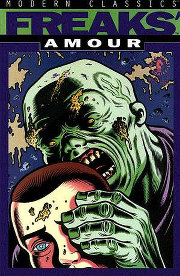Book review: 'Freak's Amour', by Tom De Haven
 Freak's Amour, by Tom De Haven, is simply a masterpiece. This is some of the best weird literature that few seem to have heard of or remember. It's been out of print for 27 years. I started it once, long ago when I was just getting into science fiction and weird genre stuff. It was a bit arty and demanding for a teenage reader, and my interest wasn't up to the challenge at the time. Now, I have to give it very high recommendation after finding it again.
Freak's Amour, by Tom De Haven, is simply a masterpiece. This is some of the best weird literature that few seem to have heard of or remember. It's been out of print for 27 years. I started it once, long ago when I was just getting into science fiction and weird genre stuff. It was a bit arty and demanding for a teenage reader, and my interest wasn't up to the challenge at the time. Now, I have to give it very high recommendation after finding it again.
I suggest that anyone into classy lit as well as furries and pulp/pop culture go get it now, even if it takes your last two bucks. It's one of those obscurities that could be worth quite a lot if it was less available – and I say that as a professional book dealer – but it earned enough acclaim to get several printings, so it's cheap and easy to get secondhand. (In fact, I've just noticed a comic/graphic novel forthcoming: info below.)
Freak's Amour reminds me of film noir at it's most ambitious, with a cast of anthropomorphic mutants, taken through a radioactive landscape of classic surrealism and cyberpunk chaos, roughed up with kinky sex and violence. It's not just dark and weird, but emotionally moving with characters that make you care about them. I must stress that the "interspecies" anthropomorphic nature of the mutated characters makes it furry-relevant (in a fetishy way, that few works of serious literature are). It also relates to "Body Horror", of the kind seen in movies by respected director David Cronenberg. Some of the material could only come from this author's beautiful imagination, before the Internet and even some furries helped make such visions more easily visible for seekers of the unusual.
While wondering what else on Earth might inhabit a similar niche, I was reminded of the 1983 novel Geek Love by Katherine Dunn. "Geek" refers to the carnival freak meaning of the word (not Trekkies), and the story follows a family of mutants. That book is better known and won great success as a National Book Award finalist, and also comes very highly recommended. It starts fun and freaky and becomes harrowing.
The two books have similar themes and almost synonymous titles. Geek Love was inspired by Dunn's fascinating lifetime experience (a story in itself), and contemporary headlines of the Jonestown massacre. Published in 1979, Freak's Amour was inspired by pop culture, the cold war, and premonitions of the Chernobyl disaster. The energy of Geek Love comes from the build-up to a world-changing event, but the energy of Freak's Amour comes from the fragmentation afterwards. The two books share no direct connection as far as I can tell, but both could complement each other for a longer comparative piece concerning artists, outsiders, and cults at the end of the world in postmodern fantastic literature.
Freak's Amour isn't uplifting, and the story isn't as neatly resolved as Geek Love. I might call it just as artfully plotted and a bit more stylish. The writing shows talent for storytelling by implication, in a way that gave me a hard time wrapping my head all the way around it (one of those books that keeps giving when re-read). It has a Blade Runner feel, with existential drama and mystery. There's a fantastic sci-fi macguffin hinted into the story, without being a corny device, because the character motivations are kept most important.
I'm just old enough to remember seeing Ronald Reagan on the news talking about nuclear war, and there are fictional settings that resonate for me that way. This book hits some of them. The same year that Freak's Amour was published was the time of one of America's darker moments, the Three Mile Island nuclear accident in March 1979. The story must have been gestating for years before that, but it may gain a little meaning by coincidence. It takes place in New Jersey, in a ghettoized neighborhood for a social underclass of freaks created by a radioactive disaster.
The main character, named Grinner, is a fish-man. He has a bit of a drug habit... the substance that gets him high is ordinary salt (that's how a classy writer puts meaning into the way his character "takes things with a grain of salt.") Grinner makes a living as an actor in a brutal kind of theater – erotic performance with other freaks and animal-people, for privileged "normal people" seeking a freak show. He wears the mask of a "normal person" on stage, but behind it his face is distorted into a permanent smile. As a mask-behind-the-mask, it puts a touch of irony on the absurdity and tragedy he experiences from the paradoxes of a fragmented world.
The book is a feast of creative metaphors and settings, although it doesn't neglect plot and character either. There's a betrayal scene set in a mutant garden that grows in a radioactive crater, alluding to the biblical story of the garden of Gethsemane. The crater came from the mysterious accident that created the world at the beginning of the book (which also set up the mystery at the end). The writing uses abstracted narrative well. In one example, Grinner tape records his interpretation of how his father told him his history. In another, he sees an evening news report about an artist who's last piece was a film of her death. There's word-play and inventive verbiage and descriptions ("his head exploded in a potluck of bone chips and brain samples"). It's not indulgent, and the writing makes sense.
Dark Horse made a comic adaptation in the '90s. The author, Tom De Haven, has been connected to comics for a long time. He's a creative writing professor, and also a licensed private investigator. That lends a nice credit for this kind of storytelling. He's known for other comic-related literary fiction set in the Great Depression, and the well-reviewed 2005 novel It's Superman. Although I haven't spent much time with his other stuff, I have the impression this debut novel might be his rawest/most original work. I'd say it begs for a movie. If you want to read something really unique that Hollywood isn't cool enough to use yet, pick up a copy now.
While looking up links for this review, I noticed that Dark Horse is releasing the comics in trade paperback just a few weeks from now! The art is by Gary Panter (famous set designer for Pee-wee's Playhouse); comics fans may note covers by Mike Mignola, Charles Burns, and James O’Barr.

About the author
Patch Packrat — read stories — contact (login required)Fursuiter and unconditional linty hugger
Comments
Post new comment